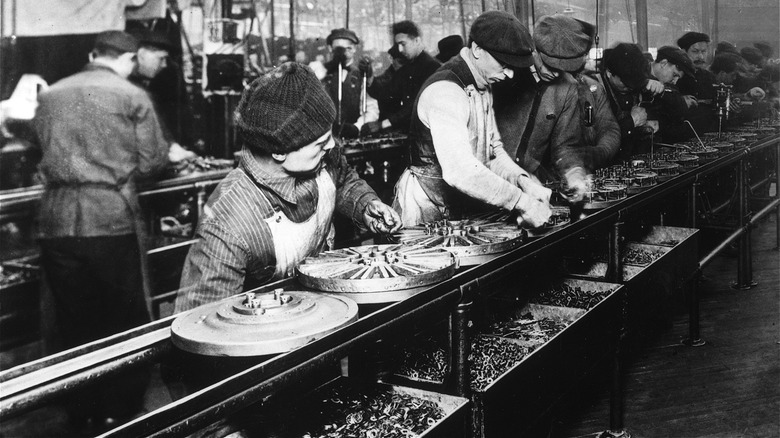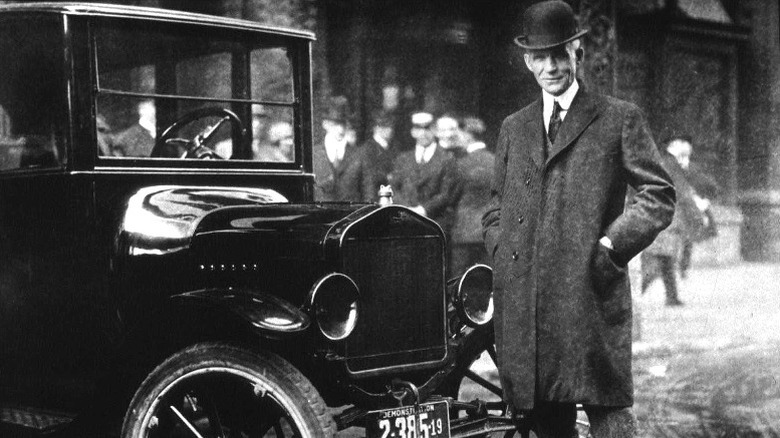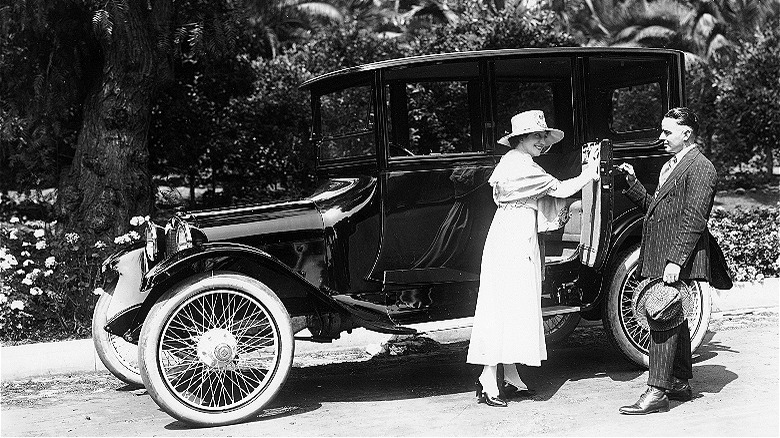Why Henry Ford Doubled Worker Wages To $5 In 1914
On January 5, 1914, workers at the Ford Motor Company saw their daily wage more than double, from $2.34 to (a potential) $5. Using the Bureau of Labor Statistics' Consumer Price Index inflation calculator, in today's dollars, this would translate to $73.09 and $156.17, respectively. Divided by an eight-hour day — which Henry Ford also changed from nine hours — the new $5 day would equal a 2024 hourly wage of $19.52, or $12.27 more than the current federal minimum wage of $7.25. This bump in pay (which was actually a profit-sharing offer) not only attracted more workers to Ford, but it also set employees up with a living wage that made it possible for them to rise up into the middle class.
The $5 announcement made for astonishing headlines at the time. One paper labeled it a gold rush ("'Gold Rush' Is Started By Ford's $5 Offer"), while The Detroit Journal wrote "Henry Ford Gives $10,000,000 in 1914 Profits To His Employees." Why exactly Henry Ford made this game-changing decision has never been clear, but experts agree it was likely a combination of several reasons, with one very likely one being a need to address mounting labor problems at the company. Before Ford's wage increase, the turnover rate at the Ford plant post-moving assembly line was a reported 370%.
It was a way to retain employees
Introduced in 1913, the integrated moving assembly line increased production efficiency for the Model T's chassis by an incredible rate. Henry Ford's assembly line cut production time by 88%; it now only took 1.5 hours to produce the car's frame, shaving off an entire 11 hours from the previous time. Not only did this mean the Ford Motor Company could produce more cars, but it also meant lower prices for consumers. (Check out the average price of a new car in 2024.)
With this said, this streamlined process also meant less for each Ford worker to do. The company started to lose its employees as a result, with the turnover rate approaching 400% by the time Henry Ford offered a ~114% bump in wages. While the HR tactic worked, it also attracted thousands more who wanted a chance to earn so much a day. According to the Ford Motor Company's timeline, an estimated 10,000 people showed up the day after Ford's January 5, 1914, announcement to apply.
What should be noted, however, is that the wage increase wasn't exactly an increase to a flat $5. Rather, the headline "Henry Ford Gives $10,000,000 in 1914 Profits To His Employees" is a more accurate description, as Ford offered employees the difference between their wage and $5 if they agreed to abide by certain guidelines, like abstaining from alcohol and keeping a clean home, as outlined in the 1915 pamphlet "Helpful Hints and Advice to Ford Employes."
The impact of Ford's profit sharing
With regard to the guidelines Ford Motor Company workers had to follow to be eligible for the $5 profit-sharing offer, Henry Ford also created a so-called Sociological Department, which was tasked with checking up on employees, their families, and their homes, unannounced. It was the ultimate in micro-managing, and as noted by The Henry Ford, employees widely disapproved of the intrusion. Eventually, Ford dissolved the department, but not until 1921.
That said, the $5-a-day plan from Henry Ford was transformative for many Americans, allowing them to enter what would be America's middle class, and afford the very cars they helped build. Ford retired the Model T in 1927, at which time the company had sold some 15 million cars. And while many Americans today may feel financially trapped in the middle class, unable to rise higher — in 1914, the middle class was a way of life that was simply unattainable at just $2.34 a day. Suddenly, though, these same workers were able to finance a home, live in better neighborhoods, and afford things beyond the essentials.
Today, workers face a similar struggle, with Bankrate putting the percentage of Americans living paycheck to paycheck at 55% to 63%. While the $7.25 federal minimum wage hasn't changed since 2009, state and local governments have taken the need for a living wage on themselves, as 30 states (plus the District of Columbia) have a minimum wage above $7.25. California, for example, one of the most expensive U.S. states to live in, has a statewide $16 minimum wage, while its fast-food workers earn $20 an hour as of April 2024.


